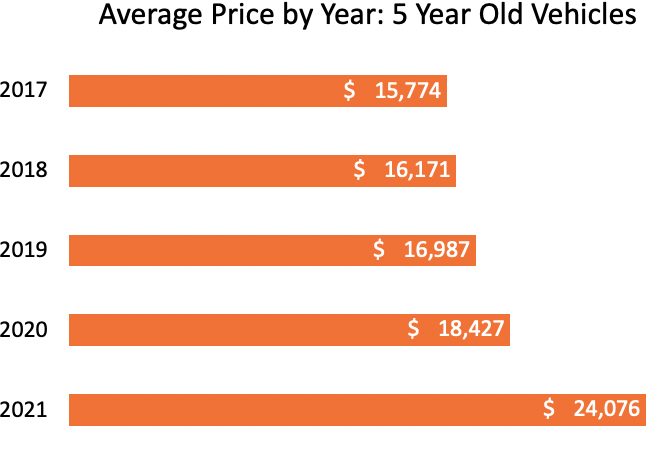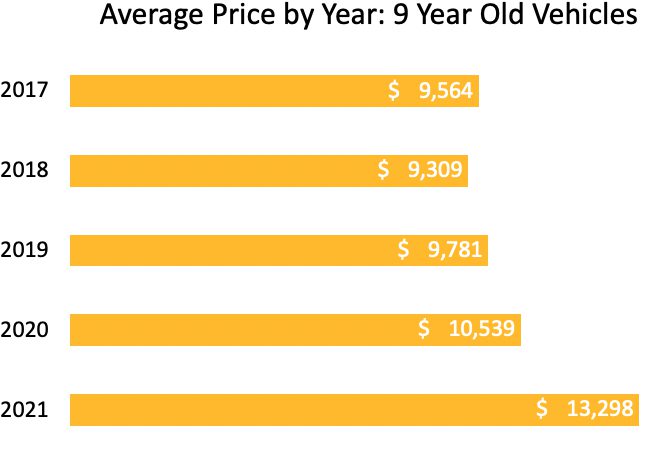Used Car Prices Are Higher — Some Far More Than Others

Introduction
You’ve probably heard by now that car prices are on the rise. Due to worldwide production shortages during the COVID-19 pandemic, fewer new cars are making their way dealership lots. And that means consumers are paying more for them.
In fact, according to data provided by Edmunds, the average new car buyer in July 2021 received a discount of just $94 off the manufacturer’s suggested retail price (MSRP). That compares with an average discount of $2331 off the sticker price last year.
With new cars in short supply, shoppers have been turning to used cars instead. That’s led to similar shortages of used cars for sale — and, you guessed it, a similar rise in prices.
But not all used cars have been affected equally. Some have seen price increases more than double those of others.
Used Car Prices by Age
It turns out that, if you want to avoid sticker shock with a used car purchase right now, vehicle age matters. We looked at recent sales data for three-, five-, seven-, and nine-year old cars and found some surprising results.
Five years ago, the average transaction price for a three-year-old car was about $21,300. As of July 2021, it’s just over $29,000. That’s an increase of $7700. Incredibly, the vast majority of that increase — $5723 — has come in 2021 alone, driven by pandemic-related shortages. That’s a 25% surge compared to prices last year.
While that may sound like a lot, it’s relatively mild compared to some other vehicle age groups.
Surprisingly, five-year-old cars have seen almost the same dollar increase in their average selling prices this year, despite their lower average price point. Last month, they cost buyers $5649 more on average than they did just one year ago. Since five-year-old cars generally sell for about $5000 less than three-year-old cars, that makes their percentage increase this year a whopping 31% (vs 25% for three-year-old vehicles).
If you think that’s bad, it gets worse.
You might assume that moving to an even older car would mitigate the effects of the recent surge in used car prices. But you’d be wrong. Seven-year-old cars have also seen price hikes on average of over $5000 this year — $5283 to be exact. While that’s a slightly smaller number than either three- or five-year-old cars, as a percentage of average transaction prices, it’s notably more. It’s a 40% jump. Ouch.
That makes a seven-year-old car, on average, the worst buy in today’s inventory-starved market.
The brightest spot in this story is nine-year-old cars. Yes, their prices are also up this year but not nearly as much as the newer age groups. In 2020, the average cost of a nine-year-old car was $10,539. Last month, it had risen by $2759 to $13,298. That’s a climb of 26% year-over-year, the second lowest percentage change in our analysis. And thanks to the relatively low average transaction prices of this oldest segment, that’s only about half the dollar increase of the other groups.
Buying Tips
With both new and used car prices on the rise, the best course of action to take is simply not to buy a car at the moment.
But that’s not always an option. And unfortunately, with the Delta variant pushing COVID-19 cases higher around the globe, it’s looking more and more like the current production shortages are here to stay for a while. In fact, CNN reports that Toyota is planning 14 new shutdowns of its factories in Japan, while other automakers are facing similar decisions.
Edmunds Senior Analyst Ivan Drury says that, with “new car discounts not really an option right now,” he’d look for a used car that’s just a few years old since they have the smallest percentage price increase at 25%.

Even better, though, are vehicles from 2012 or earlier. Nine-year-old cars are more expensive than they used to be, but where newer models have markups over $5000, the cost of the average nine-year-old car has risen by just half that much. “Give me something older that has proven reliability and is bottoming out on depreciation,” says Drury.
The good news is that modern cars are lasting longer than ever before. The average vehicle on the road is now 12.1 years old, according to research firm IHS Markit. Automotive manufacturing and development has come a long way in the last few decades, so buying an older car isn’t quite the hardship you might imagine.
If you’re new to the idea of buying an older used car, we can help. Check out the following article for more details on the benefits of buying an older car and how to go about it: How to Buy a Car the Klipnik Way and Save Thousands



